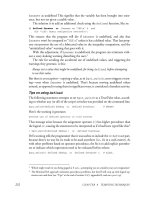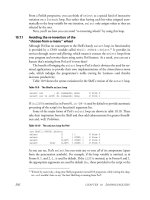Automating UNIX and Linux Administration phần 1 potx
Bạn đang xem bản rút gọn của tài liệu. Xem và tải ngay bản đầy đủ của tài liệu tại đây (648.3 KB, 11 trang )
this print for content only—size & color not accurate spine = 1.124" 592 page count
BOOKS FOR PROFESSIONALS BY PROFESSIONALS
®
Automating UNIX and Linux
Administration
Dear Reader,
If you are like me, you know a thing or two about system administration but
you are always looking for ways to be better and more efficient at it. My love for
automation combined with many years of software development and system
administration experience went into writing this extensive resource on system
administration automation.
This book does not cover the basics of UNIX and Linux administration; this
knowledge is assumed. Instead, this book shows you how to take your existing
knowledge and experience and create a complete automation system that is
efficient and reliable. Most important, the tools created and explored in this
book enable you to administer your system in a repeatable manner by
automating consistent and predictable tasks.
By following the principles and methods explained in this book, you can
save a lot of valuable time and avoid many tedious tasks. You can apply the
techniques I present to a wide range of situations: large numbers of different
systems, large numbers of identical systems, numerous groups of systems that
work together, and isolated systems that must be practically self-sufficient.
Some of the topics I cover include system installation and configuration,
data sharing, system patching and maintenance, system monitoring, security,
and user interfaces. Several solutions, including custom and open-source soft-
ware, are presented for each topic so that you can choose the best path for your
needs. This book allows you to make educated decisions at every step of the
automation process, thus enabling your systems to become more reliable and
efficient every day.
Kirk Bauer
US $49.99
Shelve in
Networking/UNIX/Linux
User level:
Intermediate–Advanced
forums.apress.com
FOR PROFESSIONALS BY PROFESSIONALS
™
Join online discussions:
Bauer
THE EXPERT’S VOICE
®
Kirk Bauer
Automating
UNIX
and Linux
Administration
CYAN
MAGENTA
YELLOW
BLACK
PANTONE 123 CV
ISBN 1-59059-212-3
9 781590 592120
54999
6 89253 15123 5
www.apress.com
Automating UNIX
and
Linux Administration
15
CHAPTER 2
Using SSH to Securely
Automate System
Administration
THE SECURE SHELL (SSH) protocol has revolutionized system administration ever
since it became popular in the late 1990s. It facilitates secure, encrypted commu-
nication between untrusted hosts over an insecure network. This entire chapter is
devoted to SSH because it plays such an important part in securely automating
system administration.
Since this book is not about installing programs, I assume that you already
have SSH installed and operating properly. I have based the examples in this book
on OpenSSH 3.1 using version 2 of the SSH protocol. If you are using another
version of SSH, the principles are the same, but the implementation details might
be different.
For a more thorough and complete discussion of SSH, I highly recommend
SSH, The Secure Shell: The Definitive Guide by Daniel J. Barrett and Richard
Silverman (O’Reilly and Associates, 2001).
2.7 The Basics of Using SSH
If you are already familiar with the basic use of SSH, you might want to just skim
this section. If, on the other hand, you are an SSH novice, you are in for quite a sur-
prise. SSH is very easy and efficient to use and can help with a wide variety of tasks.
The commands in this section work fine without any setup (assuming you
have the SSH daemon running on the remote host). If nothing has been configured,
all of these commands use password authentication just like Telnet; except with
SSH, the password (and all traffic) is sent over an encrypted connection.
To initiate a connection to any machine as any user and to start an interactive
shell, use this command:
% ssh user@host
2123_Bauer.book Page 15 Thursday, August 14, 2003 8:06 PM
This text is excerpted from Chapter 2 of "Automating Unix and Linux Administration" (Apress, 2003; ISBN: 1-59059-212-3).
Chapter 2
16
In addition to connecting to remote hosts, I often use SSH to log in as root on
my local machine because it is quicker then using
ssh-agent, as discussed later in
this chapter.
You can also execute any command in lieu of starting an interactive shell. This
displays memory usage information on the remote host:
% ssh user@host free
total used free shared buffers cached
Mem: 126644 122480 4164 1164 29904 36300
-/+ buffers/cache: 56276 70368
Swap: 514072 10556 503516
Finally, there is the scp command that allows you to copy files between hosts
using the SSH protocol. The syntax is very similar to the standard
cp command,
but if a filename contains a colon, it is a remote file instead of a local file. Like the
standard
ssh command, if no username is specified on the command line, your
current username is used. If no path is specified after the colon, the user’s home
directory is used as the source or destination directory. Here are a few examples:
% scp local_file user@host:/tmp/remote_file
% scp user@host:/tmp/remote_file local_file
% scp user1@host1:file user2@host2:
The last example copies the file named file from user1’s home directory on
host1 directly into user2’s home directory on host2. Since no filename is given in
the second argument, the original filename is used (
file, in this case).
2.8 Enhancing Security with SSH
Before SSH, telnet was widely used for interactive logins. Telnet works fine, except
that the password (well, everything actually) is sent in plain-text over the network.
This isn’t a problem within a secure network, but you rarely encounter secure net-
works in the real world. On an insecure network, other machines on the network
can capture account passwords by monitoring Telnet traffic.
2123_Bauer.book Page 16 Thursday, August 14, 2003 8:06 PM
This text is excerpted from Chapter 2 of "Automating Unix and Linux Administration" (Apress, 2003; ISBN: 1-59059-212-3).
Using SSH to Securely Automate System Administration
17
Is Your Network Secure?
Some people define an insecure network as the Internet and a secure network as
anything else. Others think that as long as there is a firewall between a private
network and the Internet that the private network is secure. The truly paranoid
(such as myself) just assume that all networks are insecure. It really depends on
how much security you need. Are you a likely target for crackers? Do you store
important, private information? Since nothing is ever 100 percent secure, I find it
easier just to assume networks are not secure and skip the rest of the questions.
If you do think you have a secure network, be sure you consider all of the possible
security vulnerabilities. Remember, employees within a company are often not
as trustworthy or security-conscious as you would like. Somebody might have
plugged in a wireless access point, for example. A person with more malicious
intentions might intentionally tap into your private network, or exploit a miscon-
figured router or firewall. Even a fully switched network with strict routing can
be vulnerable. I always try to be on the paranoid side because I’d rather be safe
than sorry.
When it comes to automating system administration tasks across multiple
systems, passwords are a real pain. If you want to delete a file on ten different
machines, logging into each machine with a password and then deleting the file is
not very efficient. In the past, many system administrators turned to
rsh for a
solution. Using a
.rhosts file, rsh would allow a certain user (i.e., root) on a specific
machine to log in as a particular user (again, often
root) on another machine.
Unfortunately, the entire authorization scheme relies on the IP address of the
source machine, which can be spoofed, particularly on an insecure network.
The most secure way to use SSH is to use password-protected public/private
Rivest, Shamir, and Adelman (RSA) or Digital Signature Algorithm (DSA) key pairs.
Access to any given account is granted only to users that not only possess the
private key file, but also know the passphrase used to decrypt that file.
Another component of SSH is a program called
ssh-agent, which allows you to
log in and enter your passphrase. This passphrase is used to decrypt your private
key, which is stored in memory for the duration of your session. This eliminates
the need to enter the passphrase every time you need to use your private key.
2123_Bauer.book Page 17 Thursday, August 14, 2003 8:06 PM
This text is excerpted from Chapter 2 of "Automating Unix and Linux Administration" (Apress, 2003; ISBN: 1-59059-212-3).
Chapter 2
18
2.9 Using RSA Authentication
Many people are more than happy to use SSH with its default password authenti-
cation. In this case, SSH is simply used as a more secure version of Telnet. The
problem is that you need to manually enter a password for every operation. This
can become quite tedious, or even impossible, when you are automating system
administration tasks. For most of the activities throughout this book, you must use
RSA (or DSA) authentication.
Even if you use RSA authentication, you still have a passphrase that is used to
encrypt the private key. You can avoid entering the passphrase every time you use
SSH in one of two ways. You can use an empty passphrase or you can use the
ssh-agent command as discussed in the next section. One major disadvantage of
empty passphrases is that they are very easy to guess, even by people with very
little skill.
Should I Use an Empty Passphrase?
Some people think that using an empty passphrase is one of the seven deadly
sins of system administration. I think that it can be appropriate within a very iso-
lated environment, especially when the security implications are minimal. For
example, a Beowulf cluster generally has an internal private network containing
only one machine with an external network connection. For instance, if the cluster
is being used by a university for research, then it might not be a very high target
for intrusion. In this case, having an unencrypted private key on one of the
cluster machines might not be too much of a concern.
However, if the same cluster were being used by a company that is doing impor-
tant and confidential research, then, at the very least, the key should not be on
the one machine with an external connection. Of course, it would be even better
to use an encrypted key along with ssh-agent. This key could be placed on a
machine completely separate from the cluster, yet it could be used to access both
the gateway and the individual nodes. This would also remove the need to have the
private key file on the cluster at all, whether encrypted or not.
The most important thing to consider is what access the key provides. If the key
provides root access to every system in your entire network, then the risks of
leaving the key unencrypted (i.e., with no passphrase) are pretty great. But if the
key only allows the Dynamic Host Configuration Protocol (DHCP) server to be
restarted on one host, then what will an attacker do with it? Perpetually restart
your DHCP server? Maybe—but that is not the end of the world, and it is easy to
fix (change keys).
2123_Bauer.book Page 18 Thursday, August 14, 2003 8:06 PM
This text is excerpted from Chapter 2 of "Automating Unix and Linux Administration" (Apress, 2003; ISBN: 1-59059-212-3).
Using SSH to Securely Automate System Administration
19
Version 2 of the SSH protocol supports two types of public key encryption:
RSA and DSA. The two encryption schemes are similar and are generally considered
to provide equivalent security. For no particular reason (apart from the fact that I am
most familiar with it), I will use RSA for the examples within this book.
2.9.1 Generating the Key Pair
The first step in the key generation process is to create your public and private key
pair. OpenSSH provides a command just for this purpose. The following command
creates a 2,048-bit RSA key pair. The default output files are
~/.ssh/id_rsa and
~/.ssh/id_rsa.pub for the private and public keys, respectively. The command
prompts you for a passphrase (which can be left blank if you so desire).
% ssh-keygen -t rsa -b 2048
Generating public/private rsa key pair.
Enter passphrase (empty for no passphrase):
Enter same passphrase again:
Your identification has been saved in ~/.ssh/id_rsa.
Your public key has been saved in ~/.ssh/id_rsa.pub.
The key fingerprint is:
3a:85:c7:e4:23:36:5c:09:64:08:78:b3:72:e0:dc:0d
What Size Key Should I Use?
The bigger the key is, the harder it is to crack, but the slower it is to use. Most
people say a 1,024-bit RSA key is good enough and almost impossible to crack.
If a 1,024-bit key is almost impossible to crack, then a 2,048-bit key is even more
difficult to crack, but I use the bigger key just in case.
When choosing a key size, you must consider the value of the information or
capabilities that the key protects. As long as your key would take more effort to
crack than the data (or power) is worth, you are okay. An excessively large key
places an unnecessarily large load on your systems.
If you are protecting data, you should also consider how long that data will be
valuable. If the data will be worthless in one month and the key would take three
months to crack, then the key is big enough. But be sure to consider that the
attacker may have specialized hardware or advanced algorithms that can crack
your key faster than you may expect.
The size of the key makes the biggest speed difference during the actual key gen-
eration process. Large keys are also more work (and therefore slower) when the
computer encrypts and decrypts data. Since SSH only uses RSA/DSA when it is
2123_Bauer.book Page 19 Thursday, August 14, 2003 8:06 PM
This text is excerpted from Chapter 2 of "Automating Unix and Linux Administration" (Apress, 2003; ISBN: 1-59059-212-3).
Chapter 2
20
initiating a new connection, the RSA key size does not affect the performance of
a session once it is established, just the initial session negotiations.
Throughout this book, I will generally show you examples that use the SSH key to
access your systems. The actual data being sent is usually not important; it will
typically contain commands to be executed and other control data. If somebody
later decrypts this traffic, it will probably be of little value.
But in some cases, the data being transferred is sensitive. In these instances, the
RSA (or DSA) key is only one thing to consider since these protocols are only used
to exchange keys for the algorithm used to encrypt the actual data. If they have
logged the SSH session, attackers can either crack the public key (by determining
its associated private key) and determine the encryption key, or they can crack
the actual encrypted data directly.
You can use the -c switch to ssh to control which cipher is used for encrypting
your session. Your options are des, 3des, and blowfish. You should avoid des
unless you need to use version 1 of the SSH protocol. The default is 3des, which is
believed to be secure, while blowfish is faster and is also believed to be secure.
2.9.2 Specifying Authorized Keys
Now that you have a public key file, you can simply place that key in any account
on any machine running the SSH server (sshd). Once the account is properly set
up, your private key will allow easy access to that account. Since it is virtually
impossible to determine the private key from a public key, only a person that
possesses the private key can access the account.
To allow access to an account, simply create
~/.ssh/authorized_keys. The file
contains one key per line (although the lines are very long—the 2,048-bit RSA key
created in the previous example is almost 400 characters long in its ASCII repre-
sentation). If the file does not currently exist, you can simply make a copy of your
public key file.
You should also be careful with your permissions because sshd is usually very
picky. In general, your home directory and the
~/.ssh directory must be only
writable by the user (and not their group, even if they have their own group). The
directory must be owned by the user as well—this can be an issue if
root’s h ome
directory is
/ and it is not owned by root. If your RSA key is not accepted, look in
the logs on the system you are connecting to; it will usually tell you why.
Here is an example that assumes that you have already copied your public key
file into your home directory in another account.
2123_Bauer.book Page 20 Thursday, August 14, 2003 8:06 PM
This text is excerpted from Chapter 2 of "Automating Unix and Linux Administration" (Apress, 2003; ISBN: 1-59059-212-3).
Using SSH to Securely Automate System Administration
21
% mkdir -p ~/.ssh
% chmod 0700 ~/.ssh
% cp ~/id_rsa.pub ~/.ssh/authorized_keys
% chmod 0600 ~/.ssh/authorized_keys
To add a second key, simply append it to the file. Once you have the file in
place, your private key alone allows you to access the account. Of course, by
default, the account password also allows access to the account. You can disable
this feature in the OpenSSH
sshd by modifying /etc/ssh/sshd_config (or the equiv-
alent on your system) and adding this line:
PasswordAuthentication no
Alternatively, you could completely disable the account password (usually
stored in
/etc/shadow and allow only RSA-authenticated logins. However, this isn’t
a good idea if the user needs that password for other services such as POP3 mail
access, FTP file transfers, and so on.
2.10 Using the ssh-agent
If you can use ssh-agent to allow passwordless operation instead of leaving your
private key unencrypted, then you will greatly add to the security of your systems.
The
ssh-agent allows you to enter your passphrase only one time per “session” and
your private key remains in memory, allowing passwordless connections for the
rest of the session.
2.10.1 Basic ssh-agent Use
Using ssh-agent is simple. You actually start your command shell or your X session
using the agent. Once logged in, you can run
ssh-agent bash
and you will have a new shell running through the agent. Or, if you use the wonderful
screen program (included with most Linux installations and available from
you can use
ssh-agent screen
to begin your screen session. I use the following script as my ~/.Xclients (or
~/.xinitrc) to allow easy use of ssh-agent within X:
2123_Bauer.book Page 21 Thursday, August 14, 2003 8:06 PM
This text is excerpted from Chapter 2 of "Automating Unix and Linux Administration" (Apress, 2003; ISBN: 1-59059-212-3).
Chapter 2
22
#!/bin/bash
cd ~
exec ssh-agent bin/startx-continue
As you can see, ssh-agent runs my startx-continue script. That script runs
ssh-add </dev/null to add the key and prompt for a passphrase (the /dev/null
causes the program to use an X window for the passphrase entry). The
startx-continue script also performs other startup tasks and finally starts the
window manager.
Once you are running the agent, you can add your private key(s) with
ssh-add:
% ssh-add
Enter passphrase for /home/kirk/.ssh/id_rsa:
Identity added: /home/kirk/.ssh/id_rsa (/home/kirk/.ssh/id_rsa)
You can also use the ssh-add utility to list the fingerprints of the keys currently
stored in the agent by running
ssh-add -l.
When you use
ssh-agent to run another command, that ssh-agent session
exists for as long as that command runs (such as your X session). Once that
command terminates, any stored keys are lost. This is fine when you can start your
entire X session as we just saw, but what if you can’t? You can use the command
shown in the next section to start a new
ssh-agent for each login. This works well,
unless you have a good number of simultaneous logins, in which case you will
have to add your SSH keys for each session. If you are in this situation, consider
using a tool called keychain that allows all of your logins on the same system to
share the same
ssh-agent easily. You can find information about this tool at
2.10.2 Advanced ssh-agent Usage
You can also use ssh-agent without starting a new process. In the bash shell (or any
POSIX-compliant shell) you can, for example, start
ssh-agent like this:
% eval `ssh-agent`
Note that those are backticks around ssh-agent; they cause the output of this
command to be passed to the
eval command that will execute the code. In fact, all
ssh-agent really does is start itself and print out some environment variables to be
set by the shell. When you use
ssh-agent to start a new process (as shown in the last
section), it just sets these variables and then creates a new process with the variables
already set. It is easy to see what is set by running
ssh-agent by itself:
2123_Bauer.book Page 22 Thursday, August 14, 2003 8:06 PM
This text is excerpted from Chapter 2 of "Automating Unix and Linux Administration" (Apress, 2003; ISBN: 1-59059-212-3).
Using SSH to Securely Automate System Administration
23
% ssh-agent
SSH_AUTH_SOCK=/tmp/ssh-XXoND8E0/agent.26962; export SSH_AUTH_SOCK;
SSH_AGENT_PID=26963; export SSH_AGENT_PID;
echo Agent pid 26963;
The SSH_AUTH_SOCK environment variable contains the path to the named
socket created by
ssh-agent to allow communication between the SSH program
and the agent. The
SSH_AGENT_PID variable contains the process ID of the agent so
that it can be killed at some point in the future.
The main disadvantage of running
ssh-agent this way is that you must kill the
agent through some external method if you want it to stop running once you have
logged out. The more basic usage causes the agent to die once the process it
executed completes.
As an example, let’s say that you have a script that executes numerous SSH
operations and you only want to enter the passphrase once. You could create the
following script:
NOTE You can find the code samples for this chapter in the Downloads
section of the Apress web site ().
#!/bin/bash
# Start the agent (don't display PID)
eval `ssh-agent` >/dev/null
# Now, ask for the key once
ssh-add
# Now, perform a bunch of SSH operations
ssh host1 'command1'
ssh host1 'command2'
ssh host2 'command3'
# Finally, kill the agent and exit
kill $SSH_AGENT_PID
exit 0
You could then run this script and it would prompt you for the passphrase
only once, store the private key in the agent, perform several operations, and then
kill the agent when it was finished.
2123_Bauer.book Page 23 Thursday, August 14, 2003 8:06 PM
This text is excerpted from Chapter 2 of "Automating Unix and Linux Administration" (Apress, 2003; ISBN: 1-59059-212-3).
Chapter 2
24
2.10.3 Key Forwarding
You can configure your SSH client to forward your ssh-agent as well. If you enable
this option, you can connect from machine to machine while your private key is
only in memory on the original machine (the start of the chain). The key itself is
never transmitted over the network. The agent is very useful when connecting to
machines on private networks. You can connect to the gateway machine and then
connect to internal machines that you cannot access directly from your workstation.
For example, you can connect to one machine as
root, and then run a script that
connects to other machines using your private key, yet your key does not actually
exist on that machine.
Be Careful with ssh-agent Forwarding!
You should never forward your ssh-agent connection to untrusted hosts (hosts
where untrusted users have root access). The root user on other systems can
not obtain your actual private key, but they can use your forwarded ssh-agent
connection to access other machines using your private key. OpenSSH lets you
specify different options for different hosts (in ssh_config) so that you can for-
ward your ssh-agent to only trusted hosts.
In addition, once you connect to another host and then use the ssh command on
that host to connect to a third host, you are using the SSH client configuration of
the second host, not the first host. That host may have been configured to for-
ward ssh-agent connections anywhere—including untrusted hosts.
So, a prudent user only forwards their agent to specific hosts. These selected
machines only allow trusted users access to the root account, and they also limit
to which hosts they will forward the ssh-agent session. You can also do this on
the command line instead of modifying the actual ssh_config file; just specify the
option -o "ForwardAgent no|yes" to the ssh command.
Also note that, in the authorized_keys file, you can restrict which remote hosts are
allowed to connect with the specified key with the from directive (discussed next in
the
“Restricting RSA Authentication” section). If you only forward your key to
certain systems, you can only allow login from those systems. If you accidentally
forward your key to some other host, it won’t work from that system anyway.
Some people also use ssh-agent in a noninteractive environment. For example,
you might have a system monitoring script that needs to connect to other machines
continuously. You could manually start the script through
ssh-agent, and then the
script could run indefinitely using the passphrase that you entered at startup. You
could even place something like this in your system’s startup scripts:
2123_Bauer.book Page 24 Thursday, August 14, 2003 8:06 PM
This text is excerpted from Chapter 2 of "Automating Unix and Linux Administration" (Apress, 2003; ISBN: 1-59059-212-3).









